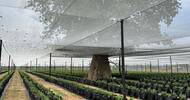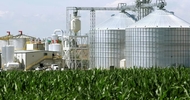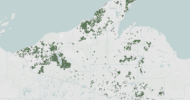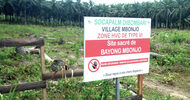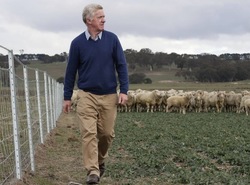
David Sackett, Growth Farms Australia, says more family farms are looking to leasing opportunities as a quick expansion option.
Growth Farms lease fund offers investors low-risk stake in ag
by Andrew Marshall
Rising demand for leased farmland has convinced agricultural asset manager Growth Farms Australia to launch a 10-year investment fund which will buy mid-sized farming properties and lease them to primary producers.
The $100 million venture is expected to acquire its first holdings later this year.
Growth Farms anticipates it will lease most land to nearby family-owned enterprises looking to expand the scale of their existing operations.
Its move comes just as annualised farmland returns achieved by major investment groups in the first quarter of 2018 lifted to 16.2 per cent, according to the Australian Farmland Index.
The index, which monitors income and capital returns from corporate and private wealth investment holdings, had slipped back to 15.9pc in December largely because farm earnings were weathered by a hot, dry 2017.
The leasing model gives farmers opportunities to expand their businesses without having to find the capital to buy more land
- David Sackett, Growth Farms Australia
Growth Farms, whose managed assets are among those monitored by the index, has looked after rural holdings for agricultural investors for almost 20 years in NSW, Victoria and Queensland.
It now has $440 million of assets (about 20 properties) under management and boasts annual pre-tax internal rates of return at 10.4pc for the past decade.
The new Australian Agricultural Lease Fund will accumulate a pool of properties, charging annual fees to leaseholders based on 4.5pc of the land’s value.
The portfolio will spread across geographies in mid- to higher-rainfall areas, from North Queensland to northern NSW, the southern Murray Darling Basin, Victoria, Tasmania and South Australia.
The ag lease fund is looking to buy farms ranging in value up to $8 million each.
Rental returns and rising property prices are expected to generate combined net returns from the investment pool of at least 10pc, giving new investors a stake in the farm sector without being directly tied to production and market fluctuations.
Growth Farms managing director, David Sackett, believed the leasing model had strong potential in the local agricultural sector.
Leasing potential grows
Farm leasing was a well established trend in the US and other markets overseas.
Other agricultural investment groups are already active in Australia, including the big US-based management and marketing specialist, Westchester, which handles more than $8 billion in farming assets in seven countries.
“The leasing model gives farmers opportunities to expand their businesses without having to find the capital to buy more land,” Mr Sackett said.
“Many existing farms are sub-scale and capital constrained. Leasing overcomes this.
“From an investor’s point of view, leasing provides a stable cash flow based on rental yield and avoids much of the volatility that comes with direct exposure to agricultural markets.”
Australian Agricultural Lease Fund’s investor support base and earnings will be assessed after five years, but the intention is to give it a 10-year life span.
Wholesale investors are now being invited to contribute a minimum of $100,000 to join the fund.
Initial arrangements with tenants will be for about three years.
Good managers required
Leasees will need to establish sound management plans and maintain the sort of sustainable environmental and land use standards expected if they owned the land themselves.
They will also be expected to actively engage with the local community and employ or train locals.
At the end of the fund’s life Mr Sackett said farmer tenants would have a chance to buy the farms.
While Australia had a strong tradition of family farmers owning freehold titles, unlike Europe and the US where smaller landholdings were often rented as part of larger aggregations, he said Growth Farms received increasing inquiry for leasing deals.
The company now leases about 10pc of the country it manages and had no shortage of offers from more potential tenants.
He said while the new fund’s 4.5pc rental rate may be considered a “bit of a stretch” for some aspiring leasees in the livestock sector, in the wake of recent jumps in grazing land values, it was “certainly not at the top” of the leasing market’s range.
Mr Sackett said the fund’s decision to buy properties may even be guided by farmers identifying land in their district which they were keen to lease rather than buy at this stage.
“If somebody with an existing family operation sees a place next door, we may well be interested, although we won’t be rushing into buying anything,” he said.
“We’ve been in this game, looking after other people’s investments, for a quite a while and we know the sort of discipline required.”
Acquisition opportunities would likely range from sugar cane country to irrigated grain and dairy properties, with the fund paying attention to areas where current seasonal or commodity market trends may make land valuations more attractive.
Land values to rise
Growth Farms expected farmland values to appreciate over the long term at 2pc to 3pc more than the consumer price index, thanks to rising commodity prices and productivity gains.
Capital returns in high rainfall areas had averaged 6pc in the past 40 years.
Latest farmland index data, compiled by the National Council of Real Estate Investment Fiduciaries in the US, put total return growth from investment properties in the first quarter of 2018 at 0.44pc – well above the 0.12pc recorded a year earlier.
Data contributor AAG Investment Management noted March 2018 annualised income returns were, however, nearly half that of the previous year of 8.06pc because of a generally drier winter cropping season in 2017, weaker grain prices, and softening in beef and lamb markets.
But land value returns continued growing, from 8.4pc in March 2017 to 11.8pc.
“This was driven by strong demand for quality broadacre and permanent cropping properties, with avocado, citrus, nut and table grape properties experiencing particularly strong demand,” said AAG.
The farmland index monitors 67 properties with a combined market value of almost $1.3b.



